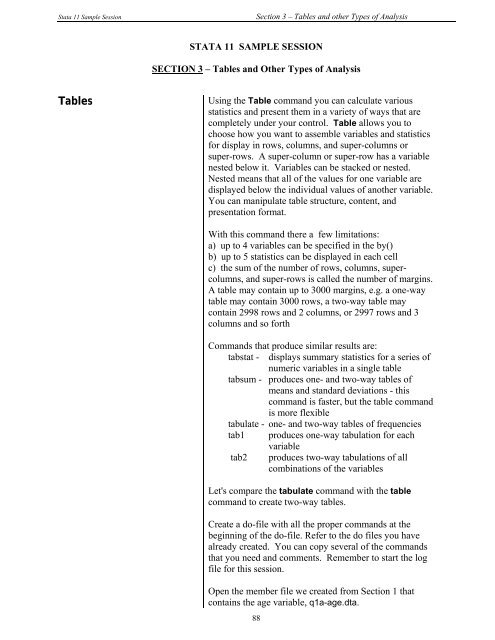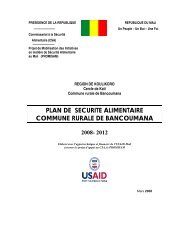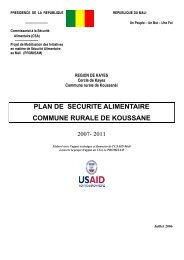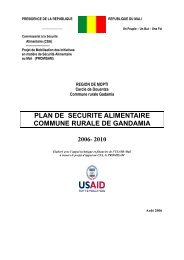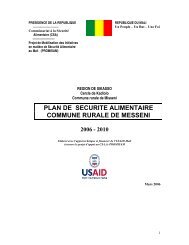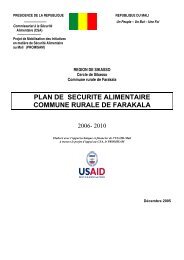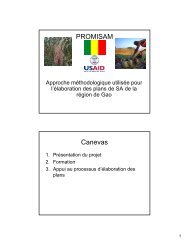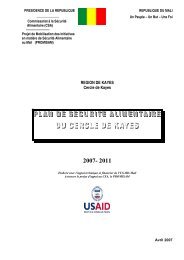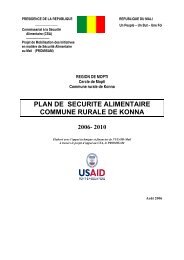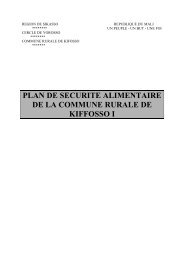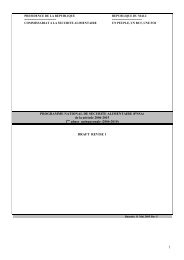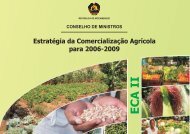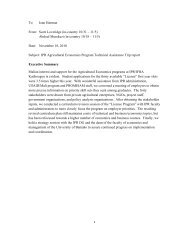STATA 11 for Windows SAMPLE SESSION - Food Security Group ...
STATA 11 for Windows SAMPLE SESSION - Food Security Group ...
STATA 11 for Windows SAMPLE SESSION - Food Security Group ...
You also want an ePaper? Increase the reach of your titles
YUMPU automatically turns print PDFs into web optimized ePapers that Google loves.
Stata <strong>11</strong> Sample Session Section 3 – Tables and other Types of Analysis<br />
Tables<br />
<strong>STATA</strong> <strong>11</strong> <strong>SAMPLE</strong> <strong>SESSION</strong><br />
SECTION 3 – Tables and Other Types of Analysis<br />
Using the Table command you can calculate various<br />
statistics and present them in a variety of ways that are<br />
completely under your control. Table allows you to<br />
choose how you want to assemble variables and statistics<br />
<strong>for</strong> display in rows, columns, and super-columns or<br />
super-rows. A super-column or super-row has a variable<br />
nested below it. Variables can be stacked or nested.<br />
Nested means that all of the values <strong>for</strong> one variable are<br />
displayed below the individual values of another variable.<br />
You can manipulate table structure, content, and<br />
presentation <strong>for</strong>mat.<br />
With this command there a few limitations:<br />
a) up to 4 variables can be specified in the by()<br />
b) up to 5 statistics can be displayed in each cell<br />
c) the sum of the number of rows, columns, supercolumns,<br />
and super-rows is called the number of margins.<br />
A table may contain up to 3000 margins, e.g. a one-way<br />
table may contain 3000 rows, a two-way table may<br />
contain 2998 rows and 2 columns, or 2997 rows and 3<br />
columns and so <strong>for</strong>th<br />
Commands that produce similar results are:<br />
tabstat - displays summary statistics <strong>for</strong> a series of<br />
numeric variables in a single table<br />
tabsum - produces one- and two-way tables of<br />
means and standard deviations - this<br />
command is faster, but the table command<br />
is more flexible<br />
tabulate - one- and two-way tables of frequencies<br />
tab1 produces one-way tabulation <strong>for</strong> each<br />
variable<br />
tab2 produces two-way tabulations of all<br />
combinations of the variables<br />
Let's compare the tabulate command with the table<br />
command to create two-way tables.<br />
Create a do-file with all the proper commands at the<br />
beginning of the do-file. Refer to the do files you have<br />
already created. You can copy several of the commands<br />
that you need and comments. Remember to start the log<br />
file <strong>for</strong> this session.<br />
Open the member file we created from Section 1 that<br />
contains the age variable, q1a-age.dta.<br />
88


